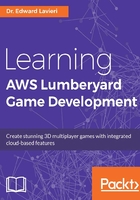
Beta software
As you likely know, the Lumberyard game engine is, at the time of this book's publication, in beta. What does that mean? It means a couple of things that are worth exploring.
First, developers (that's you!) get early access to amazing software. Other than the cool fact of being able to experiment with a new game engine, it can accelerate game projects. There are several downsides to this as well. Here are the primary drawbacks of using beta software:
- Not all functions and features will be implemented. Depending on the engine's specific limitations, this can be a showstopper for your game project.
- Some functions and features might be partially implemented, not function correctly, or be unreliable. If the features that have these characteristics are not ones you plan to use, then this is not an issue for you. This, of course, can be a tremendous problem. For example, let's say that the engine's gravity system is buggy. That would make testing your game very difficult, as you would not be able to rely on the gravity system and not know if your code has issues or not.
- Things can change from release to release. Anything done in one beta version is apt to work just fine in subsequent beta releases. Things that tend to change between beta versions, other than bug fixes and improvements, are interface changes. This can slow a project up considerably, as development workflows you have adopted may no longer work.
In the next section, you will see what changes were ushered in with each sequential beta release.
Release notes
Amazon initially launched the Lumberyard game engine in February 2016. Since then, there have been several new versions. At the time of this book's publication, there were five releases: 1.0, 1.1, 1.2, 1.3, and 1.4. The following figure shows the timeline of the five releases:

Let's look at the major offerings of each beta release.
Beta 1.0
The initial beta of the Lumberyard game engine was released on February 9, 2016. This was an innovative offering from Amazon. Lumberyard was released as a triple-A cross-platform game engine at no cost to developers. Developers had full access to the game engine along with the underlying source code. This permits developers to release games without a revenue share and to even create their own game engines, although they're not distributable, using the Lumberyard source code as a base.
Beta 1.1
Beta 1.1 was released just a few short weeks after Beta 1.0. According to Amazon, there were 208 feature upgrades, bug fixes, and improvements with this release. Here are the highlights:
- Autoscaling features
- Component Entity System
- FBX Importer
- New Modular Gems
- Cloud Canvas Resource Manager
- New Twitch ChatPlay Features
- Initial support for Android and iOS
You will gain exposure to the Component Entity System throughout this book and learn about the FBX Importer in Chapter 4, Creating 3D Characters; Game Gems in Chapter 8, Bringing Your Game to Life with Audio and Sound Effects and Chapter 9, Employing Cloud Computing and Storage; Cloud Canvas Resource Manager in Chapter 9, Employing Cloud Computing and Storage; and Twitch ChatPlay in Chapter 10, Engaging With Users Using Twitch.
Beta 1.2
In just a few short weeks after beta 1.1 was released, beta 1.2 was made available. The rapid release of sequential beta versions is indicative of tremendous development work by the Lumberyard team. This also gives some indication as to the amount of support the game engine is likely to have once it is no longer in beta.
With this beta, Amazon announced 218 enhancements and bug fixes to nearly two dozen core Lumberyard components. Here are the main Lumberyard game engine components that were upgraded in beta 1.2:
- Particle Editor
- Mannequin
- Geppetto
- FBX Importer
- Multiplayer Gem
- Cloud Canvas Resource Manager
We will explore Mannequin in Chapter 5, Animating Your Characters; Geppetto and the FBX Importer in Chapter 4, Creating 3D Characters; the Multiplayer Gem in Chapter 7, Creating Multiplayer Gameplay; and the Cloud Canvas Resource Manager in Chapter 9, Employing Cloud Computing and Storage.
Beta 1.3
The three previous beta versions were released in subsequent months. This was an impressive pace, but likely not sustainable due to the tremendous complexities of game engine modifications and the fact that the Lumberyard game engine continues to mature. Released in June 2016, the Beta 1.3 release of Lumberyard introduced support for Virtual Reality (VR) and High Dynamic Range (HDR). We will talk about VR and Lumberyard in Chapter 12, Stretching Your Lumberyard Wings.
Adding support for VR and HDR is enough reason to release a new beta version. Impressively, this release also contained over 130 enhancements and bug fixes to the game engine. Here is a partial list of game engine components that were updated in this release:
- Volumetric Fog
- Motion Blur
- Height Mapped Ambient Occlusion
- Depth of Field
- Emittance
- Integrated Graphics Profiler
- FBX Importer
- UI Editor
- Flow Graph Nodes
- Cloud Canvas Resource Manager
Beta 1.4
At the time of this book's publication, the current beta version of Lumberyard was 1.4, which was released in August 2016. This release contained over 230 enhancements and bug fixes as well as some new features.
The primary focus of this release seemed to be on multiplayer games and making them more efficient. One example of increased efficiency is the addition of an in-editor Lua script editor. The result of the changes provided in this release is greater cost-efficiency for multiplayer games when using Amazon GameLift. You will learn about Amazon GameLift in Chapter 7, Creating Multiplayer Game Play.